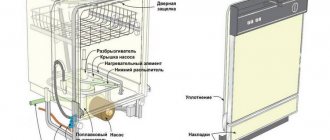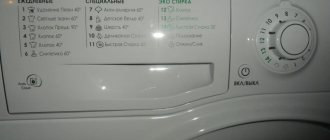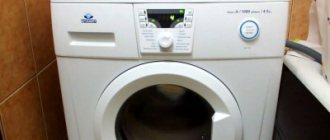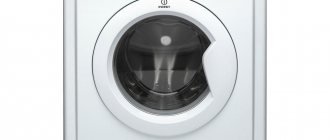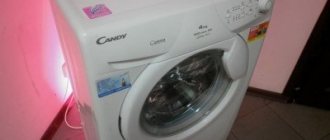Video Difficulty of repair
If you just bought a dishwasher, you will need help. If the instructions are written dryly and unclearly, from our article you will learn how to use the dishwasher correctly. As well as operating rules that will help extend the operation of equipment for many years.
What you need to know when using the dishwasher for the first time
It doesn’t matter what brand your machine is (Hansa, Bosch, Beko), the design and rules of use are similar. You need to understand where the main components and parts are located, as well as the principle of their operation:
- Camera door. When the equipment is operating, it can be locked so as not to open accidentally.
- Hopper with baskets, hooks and shelves. Dishes are placed here: plates, cups, glasses, cutlery.
- Sprayers. They can be located at the bottom and top of the chamber. Jets of water fly out from the sprinkler nozzles, washing away contaminants from the devices.
- The control panel is electromechanical, electronic, touch. For a built-in machine it is located at the end of the door, for a free-standing machine it is on the outer panel.
- The salt compartment is located next to the drain filter, at the bottom of the pan.
- Compartments and detergent dispensers are located on the door.
A special pump is responsible for circulating water in the system. The drain pump pumps out water, and the electronic board controls the work processes.
After delivering your dishwasher to your home, are you in a hurry to unpack and load the machine? Not so simple. First you need to do a test wash.
How to install and connect a dishwasher, read the article. We will remind you of the main steps:
- install the equipment in place (in a closet, niche, between cabinets); make sure the floor is perfectly level;
- connect the housing to the communications (drain and water supply);
- Connect the plug to a moisture-resistant Euro socket with mandatory RCD protection.
Now you need to run a test wash of an empty machine. This will help clean the dishwasher after transportation and storage in the warehouse, as well as check the quality of the connection.
- open the hopper door;
- remove the lower basket;
- open the salt reservoir;
- pour water into it;
- depending on the hardness of the water, add the required amount of special salt - it softens the water and removes heavy impurities;
In some models "Bosch", "Siemens", "Hansa", "Indesit" it is possible to set the degree of hardness. Adjust the position on the panel, then the equipment will take as much salt as needed.
You will know when you need to add salt by the indicator light on the panel.
Remember the basic rules after purchasing PMM:
- The equipment cannot be turned on if damage or an uneven floor surface is detected.
- The first start is idle, without dishes.
- Set to medium cycle and high temperature.
What should you pay attention to when choosing technology?
When choosing the optimal machine model, it is important to take the time to study the capabilities and characteristics of the offered equipment. In addition to class, size and installation method, several other aspects matter.
The material from which the tank, rocker arms and baskets are made affects the durability of the units. It is important that as few parts and assemblies are made of plastic.
The capabilities of the technology and its contents are also important to the user. Various modes allow you to better cope with the task. For example, the “soaking” mode helps to more effectively wash off dried dirt.
Dishwasher washing modes are described in the instructions
An installed system for determining the degree of water purity is necessary for the control unit to make a decision about draining the water or reusing it. Built-in drying is also very useful for owners. In everyday life, it is convenient to wash dishes with a half load.
Dishwasher Whirlpool ADPF 851 WH
Models are available with mechanical or electronic control. Most modern equipment is equipped with the second option, although it is considered less reliable.
BEKO DSFN 6530 dishwasher control panel
The noise level produced by a running unit is often of great importance. Especially for families with small children. It can vary in the range of 38...55 dB. To prevent the machine from causing inconvenience, it is better if the indicator does not exceed 45 dB.
The reliability of equipment is largely determined by the country of manufacture and manufacturers. Products manufactured by Miele, Electrolux, Bosch or AEG have long been proven for their quality.
Video - Electrolux ESF45055XR dishwasher
Of course, these brands cost a lot. Italian technology also performs well.
Italian kitchen appliances Smeg
Many people are suspicious of the products of Chinese factories, but recently decent models can be found in this segment.
Xiaomi smart dishwasher
How to load dishes correctly
Having figured out the choice of programs and launch, study the rules for arranging devices in the chamber. In PMM Electrolux (Electrolux), “Kandy”, “Beko” the location and type of baskets may be different. If you follow the instructions, everything seems simple. But the difficulty is that rarely does anyone use standard utensils. That's why:
- Clear plates of any leftover food.
- Place large utensils in the lower basket: frying pans, pots, baking trays. Place them sideways so as not to block the flow of water. It is better to place pots upside down.
- When placing plates in the holders, do not place them tightly, otherwise they will not wash off. Leave a little space.
- Place large dishes and plates on the edge, smaller cutlery in the center.
- Do not overload or place plates on top, otherwise nothing will wash off.
- Place cups and saucers in the upper basket.
- Place spoons, knives, and forks in the special cutlery compartment.
- If there is a glass holder, use it for its intended purpose.
- Make sure that large objects do not block the sprayer.
Before loading, take a look at the outside of the plate. Usually there is an acceptable washing icon.
Read about which dishes can be washed in the dishwasher in a separate article. Let's remember the main thing:
- It is prohibited to place items made of silver, earthenware, or wood into the chamber.
- Not heat-resistant plastic and glass utensils.
- Damaged items.
- Copper, tin, aluminum appliances.
This is the icon on the plates that allows you to wash them in a car:
Ion exchanger with salt - principle of operation and purpose
Some dishwasher owners mistakenly believe that sodium regenerating salt and detergent are the same thing. However, these compositions perform different functions, and in addition, they are poured into different containers. The powder is poured into a container located in the hatch of the device, salt is added to the reservoir located at the bottom of the washing chamber.
Of course, you can find special “tablets” that already contain the required amount of salt. This product is placed in the dishwasher lid reservoir. But if the tap water is too hard and contains a large amount of calcium and magnesium, then it is advisable to use a special salt composition for the ion exchanger. Otherwise, the device will fail quite quickly.
Every dishwasher has an ion exchanger. It contains a resin consisting of sodium chloride. Water intended for washing dishes from the water supply first enters the ion exchanger, where sodium ions replace calcium and magnesium contained in the liquid. This chemical reaction allows you to avoid the formation of scale on machine parts, as well as the appearance of stains on washed dishes.
As the device operates, the sodium salt is gradually washed out of the unit. In this case, it is necessary to use special dishwashing compounds in which the NaCl content exceeds 99% to add a new portion. The use of ordinary table salt is prohibited.
The consumption of sodium salt depends on the operating mode of the machine. Most often it can be configured manually. However, in the future you will have to constantly monitor the composition of the water and, if necessary, make additional adjustments.
Advice! To simplify your task and eliminate the need for manual adjustment, it is recommended to immediately purchase devices complete with a stiffness sensor. In this technique, all settings are done automatically, and salt consumption will be as economical as possible.
You might be wondering: how to choose a dishwasher.
This is interesting: Steam mop: what it is, how it works, pros and cons
Detergent
Choosing a cleaning product is not an easy task. You usually have to experiment before you find what's right for you. Let's look at the most popular offers:
- Tablets 3-in-1 or 7-in-1. Convenient use: do not crumble, already contain freshener and salt. According to the manufacturer, there is no need to add anything else. However, the tablet is not always convenient to use. When loading a compact dishwasher or choosing a half load, you will not be able to reduce the dose. Although some housewives cut the tablets into 2 parts (this does not apply to capsules with liquid gel).
- Powders, gels. They dissolve quickly even in short cycles, are inexpensive, and are used more economically.
- Rinse aid. Allows dishes to shine and squeak. It is poured once and for a long time until the indicator lights up.
In our other publication you will find out which dishwasher detergent is best to choose. As you understand, salt and rinse aid are added once for several cycles. Detergent must be added before each load.
Additional functional elements
The above dishwasher parts are standard for this class of household appliances. But every manufacturer strives to improve its technology, adding new functions to it by installing elements.
- Sensor for determining water purity. This sensor helps the dishwasher automatically select a dishwashing program (amount of detergent and water, temperature).
- Sensors that detect the presence of rinse aid and salt are installed in the vast majority of models.
- Sensor Dry is a drying sensor that measures the ambient temperature, relative to which the PMM will determine the method of drying dishes. This sensor is installed in expensive dishwasher models such as Miele G4263Vi.
- A “beam on the floor”, red or green, depending on the stage of the program, is available in all modern washing machines. In a Bosch dishwasher, as well as a Siemens dishwasher, this indication can show the remaining time and the progress of the program.
- A special rocker for washing baking sheets and a holder for glasses is present in some models, but more often it is purchased separately.
In addition to the above, PMM can also be divided according to dimensions (large, small, narrow), the material of the rocker arms and their quantity, and the different design of the baskets. Most dishwashers can be built into kitchen furniture. In Bosch machines, the baskets can be adjusted in height; in other models they may have folding elements. Also, the difference may be in the software itself.
You can learn about the features of each model from the instructions that come with the unit. It shows the installation diagram and electrical connection diagram of the device.
You may be interested in: rating of the best dishwashers of 2020.
Selecting a program in PMM
You have loaded the dishes and added the detergent. It's time to choose a washing mode, which determines how much water the equipment uses. Focus on the degree of contamination of the dishes. The stronger it is, the longer the program is better to install.
If there is not enough room for a full load of appliances, set the mode to 1/2. Then the machine will consume 30% less water and electricity.
Let's look at the main programs that are used most often:
- Daily (50-65 degrees). You can wash a variety of moderately soiled dishes.
- Delicate (30-40 degrees). For products made of fragile materials.
- Economical (50 degrees). For lightly soiled devices. Saves resources.
- Intensive (70 degrees). Helps get rid of heavy dirt and deposits.
- Machine. The system independently selects the optimal mode based on the load and degree of contamination.
If you have a model without built-in, then press the necessary keys on the external panel.
Design and types of drying system
The drying system is available in several versions:
- Drying naturally. Occurs due to moisture condensation. Takes several tens of minutes.
- By increasing the temperature of the heating component, which is located at the bottom of the machine. This leads to evaporation of water. No energy is wasted.
- Using a fan. In this case, the dishwasher must be equipped with a fan. Hot air is blown onto the washed dishes. Noisy when in use. Wastes electricity. If you choose a dishwasher with a built-in fan, you should pay attention to sound insulation.
- Thanks to the pressure difference located in the compartment for dishes and water.
- Using zeolite. It is placed at the bottom of the dishwasher. When water hits it, it generates heat. There is no need to replace it. He is capable of regeneration. Consumes less energy than a fan.
Tips for caring for your dishwasher
Any equipment needs care; it should not be used for wear and tear. After finishing washing, open the door and remove the dishes. Then remove the lower basket.
- Unscrew the filter in the pan and its mesh.
- Rinse the parts under pressure from the tap.
- Remove the damper and clean the impeller (no more than once a month).
The filter in the dishwasher should be cleaned after each wash or at least 2 times a month. Once every six months the machine is idled along with cleaning products.
- Leave the door open for ventilation.
- Clean rubber seals.
During operation, adhere to safety precautions:
- Do not touch the PMM body with wet hands during operation.
- Connect to a grounded outlet.
- Do not accidentally open the door, otherwise the hot jet may come into contact with your skin.
You can safely start the car.

